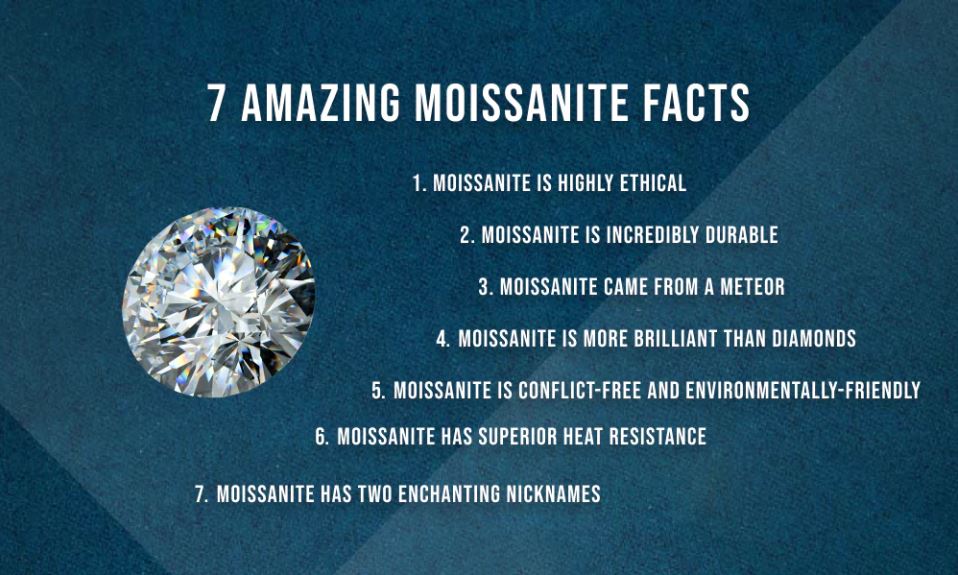Discover 7 moissanite facts that make this show-stopping diamond alternative so enchanting. Moissanite is a stone with so many benefits, not just for now but for a lifetime. Gorgeous and sustainable, moissanite is a budget-friendly, socially-conscious choice for so many, increasing in popularity worldwide and for the future.
This blog post will cover the following topics: Moissanite is Highly Ethical, Moissanite is Incredibly Durable, Moissanite Came From a Meteor, Moissanite is More Brilliant Than Diamonds, Moissanite is Conflict-Free and Environmentally-Friendly, Moissanite Has Superior Heat Resistance, and Moissanite Has Two Enchanting Nicknames. Uncover what makes moissanite so unique and why you should make it your next keepsake purchase.
What is Moissanite
Moissanite contains a wealth of intriguing information hiding within its unforgettable fire and brilliance. Learn about the origin of this stunning gemstone, the optical and physical properties, and lab-grown techniques of this popular diamond alternative, and remember these moissanite facts make it all the more exciting. Want more knowledge?
Chemical Properties:
Both lab-grown moissanite and natural moissanite are composed of silicon carbide (SiC), where a carbon atom is surrounded by four silicon atoms arranged in a tetrahedral form.
Physical Properties:
Moissanite has distinctive physical properties, making it a stand-out stone among all your diamond alternative choices. This includes:
Durability:
Moissanite measures 9.25 on the Mohs scale of hardness, a convenient way of identifying minerals and their scratch resistance tendencies using a rating from 1-10. A diamond measures a 10. This means moissanite is also very durable and scratch-resistant.
Refractive Index:
Minerals are measured on the refractive index scale. The refractive index scale measures how much light passes through the stone. Moissanite has a refractive index of 2.648 -2.691 and a dispersion of 0.104 with an adamantine luster and noticeable double refractivity. This results in a stunningly brilliant and fiery stone.
Where is Moissanite Found?
Natural moissanite and lab-grown moissanite have different origins.
Natural Moissanite: Dr. Henri Moissan, the recipient of the Nobel Prize in 1893, made a significant breakthrough by uncovering natural moissanite within an Arizona meteorite crater. Such rarity contributes to the value of natural moissanite, making it very expensive.
Synthetic Moissanite: This refers to most moissanite on the market featuring budget-friendly price points available in popular shapes, various carats, and mountings.
The Production Process of Synthetic Moissanite:
Environment: Synthetic moissanite is created in a controlled laboratory environment using a time-intensive process involving pressure and heat, requiring 2-3 months to form a single gem.
Process: The lely process is used to grow sizable silicon carbide crystals by heating pure silicon and carbon within an inert atmosphere.
Cut & Shape: The moissanite crystals are cut and faceted into popular shapes commonly associated with diamonds and other gemstones, ready to be set into fine jewelry pieces for sale. Want to figure out your preferred shape? Check out our other blog, The Sparkle Factor: Which Moissanite Cut Sparkles the Most?
7 Amazing Moissanite Facts You Should Know
Here are seven amazing facts you should know about moissanite.
1) Moissanite is Highly Ethical
Origin: Lab-grown moissanite is unlike natural diamonds and colored gemstones because it is engineered in a lab setting, not mined from the earth, reducing the environmental impact often associated with painstaking natural gemstone extraction.
Sustainability: The synthetic production process ensures the gem's origin and promotes sustainable practices. Synthetic moissanite does not create an unsuitable work environment with hard labor and is not associated with human rights violations and environmental damage because of its man-made origin. Moissanite is a conflict-free alternative that provides peace of mind to conscientious consumers. By choosing moissanite, individuals can feel great about selecting an ethical option without compromising quality, style, or size.
2) Moissanite is Incredibly Durable
Scratch-Resistant: Moissanite has exceptional durability, meant to withstand the test of time. With a hardness rating of 9.25 on the Mohs scale, moissanite is second only to diamonds in terms of hardness, which rates a 10. This durability makes moissanite highly resistant to scratching, abrasion, chipping, and breaking, allowing it to maintain its glamorous appearance even with daily wear. This makes moissanite a practical choice for engagement rings, men’s rings, wedding bands, and other fine jewelry pieces.
3) Moissanite Came From a Meteor
Straight from the galaxy far, far away, and part of your bespoke jewelry collection! Natural moissanite is exceedingly scarce, limited to minute quantities within certain geological formations like kimberlites, lamproites, and meteorites.
When meteorites containing moissanite strike the earth, it allows for discovery in small quantities within this rare impact area, initially discovered by Dr. Henry Moissan. These exciting occurrences make moissanite a fascinating and magical gemstone, bridging the limitless gap between the celestial and terrestrial realms.
Unravel the mystery of the infinite galaxy with such a beautiful stone--reimagined in a lab and waiting for your selection. Get lost in its fire, sparkling within the meteorite crater.
4) Moissanite is More Brilliant Than Diamonds
Moissanite possesses an impressive brilliance exceeding diamonds, lab-grown diamonds, and diamond simulants/alternatives. Moissanite's optical properties contribute to its exceptional fire and sparkle.
The refractive index measures how light bends as it enters a gemstone, showcasing fire. Moissanite's refractive index is higher than that of diamonds. As mentioned before, moissanite has a refractive index of 2.648 -2.691, and diamond is 2.42. When compared side by side, moissanite's brilliance can be even more striking and eye-catching than that of diamonds, cubic zirconia, strontium titanate, YAG, GGG, and other diamond alternatives, natural or synthetic. This is because moissanite has an ultra-shiny disco ball or rainbow effect as the light reflects off the facets not visible in other stones.
5) Moissanite is Conflict-Free and Environmentally-Friendly
Synthetic moissanite is highly sought-after for its conflict-free and environmentally-friendly attributes due to its lab-grown origins. This step-b-step technological production bypasses all mining, reducing disruption of the ecosystems.
Lab-grown moissanite isn't linked to exploitative labor practices or human rights violations due to its origin. Moissanite offers a guilt-free alternative to natural diamonds and natural colored stones associated with unethical mining.
Frequently Asked Questions
Have questions? Below is a list of our commonly asked questions.
Is moissanite a sustainable alternative to diamond?
Yes, moissanite is a sustainable alternative to natural earth-mined diamonds. Natural diamonds are mined from the earth; moissanite is created in controlled laboratory settings. This modern process eliminates the need for mining, reducing the ecological impact and avoiding associated environmental issues such as habitat destruction.
What colors does moissanite come in?
In its purest form, lab-grown and natural moissanite are typically colorless or near-colorless, resembling the appearance of a high-quality diamond. However, some moissanite gemstones may display subtle tints of yellow, green, or gray. Moissanite can also be treated or enhanced to exhibit fancy colors such as blue, green, or pink.
Is moissanite a natural or synthetic gemstone?
Natural moissanite is extremely rare and occurs in small quantities in specific geological formations initially discovered by Dr. Henri Moissan in a meteorite crater in Arizona in 1893.
Synthetic moissanite is created in the laboratory and exhibits the same physical and optical properties as natural moissanite.


